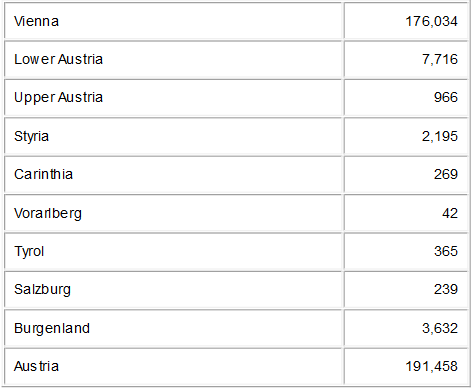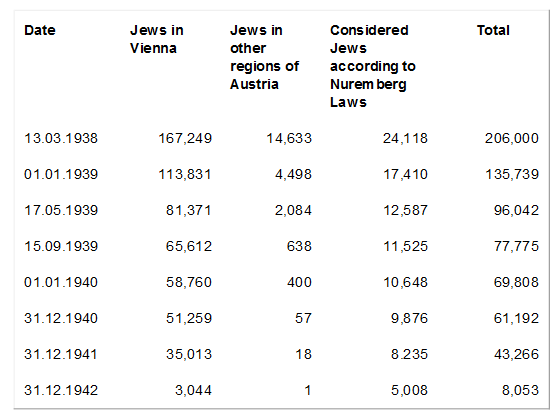Demography and Immigration
Jewish population of Austria in 1934

By 1880, 72,588 Jews lived in Vienna, 118,495 resided there in 1890, their number grew to 146,926 in 1900, and 175,318 in 1910. The percentage of Jews living there skyrocketed from 2.16 in 1857 to 10.06 in 1880; the growth of Vienna's Jewish population was unmatched anywhere else in Europe except Budapest, the second capital of Austria-Hungary.The constitutional rights that were granted to Jews between 1848 and 1867, and especially the right to reside wherever they wished, to own property, and to enter professions, had facilitated the growth of the Jewish population in Austrian cities.
By the end of the 19th century Austria had a Jewish population second only to Russia. Vienna's Jewish population numbered only about 1,600 in 1830. It grew to approximately 4,000 in 1846 and to 6,217 in 1857. Thereafter Jews migrated to the Austrian capital in unprecedented numbers.
By 1934 there were 191,458 Jews living in Austria. When the Nuremberg Racial Laws were introduced after Austria's annexation to Germany, 34,500 persons, who had not been identified as Jews in the census of 1934, were classified as "racial Jews" .
By the end of November 1939, over 120,000 Jews had left Austria. 66,260 Jews remained in Austria along with about 30,000 "racial" Jews, as described by the Nazis. The deportation of Austrian Jews to concentration camps began in October 1939.
In addition to the approximately 50,912 Jews deported from Austria to ghettos and extermination camps, another 17,050 were arrested in other European countries after the Germans occupied them.
An estimated number of 800 Jews survived in Austria by the end of the war by working for the Jewish Council, protected by a marriage with a non-Jew or by hiding underground after the dissolution of the Jewish community in November 1942.
Demography of Austrian Jews during 1938-1942

Nature of Immigration to Austria
In the roughly seven decades preceding the outbreak of the First World War, the nature of Jewish immigration to the Austrian changed considerably. Until the 1870s Jews immigrated to Austria mostly from Bohemia and Moravia. Having already adopted the German language, even before 1848, and being well-educated, they had little difficulty in adjusting to life in the Austrian metropolis. The same, for the most part, could be said of the second wave of immigrants, which came from Hungary.
After 1867 the geographic origins of Jewish immigrants to Austria began to change drastically. Immigrants from Galicia, usually non-German speaking and often religiously observant, constituted the major part of Jewish immigrants. As early as 1880, 18 percent of the Jews living in Vienna were born in Galicia; that figure grew to 23 percent in 1910. Their absolute number jumped from 13,180 in 1880 to 30,325 30 years later.
Whereas the emigration of Galician Jews until 1880 was motivated primarily by the dire economic conditions of their province, emigration after 1881 from what had once been Poland was additionally propelled by pogroms organized by the Russian minister of the interior, Nicholas Ignatiev. These pogroms spread to over one hundred locations and lasted nearly a year (1881-82); they were followed by a mass of anti-Jewish legislation.
Due in part to these newcomers from Galicia and Russia, Vienna, with 146,926 Jews, had the largest Jewish population in the dual monarchy in 1900.
In the "inner Austrian" crown lands, those areas that would make up the Austrian Republic after 1919, the Jewish population remained very small. Graz, which had the second largest Jewish population after Vienna, was home to only 1,971 Jews (1.3 percent of its total population) in 1910 and to 2,456 in 1932.